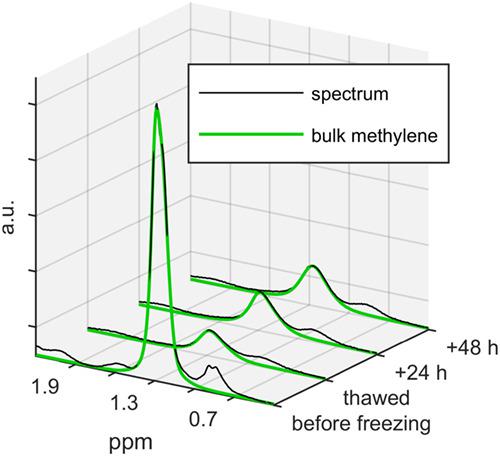当前位置:
X-MOL 学术
›
NMR Biomed.
›
论文详情
Our official English website, www.x-mol.net, welcomes your feedback! (Note: you will need to create a separate account there.)
Noninvasive in situ proton MRS in muscle tissue and bone marrow as a novel approach to identify previous freezing in a completely thawed cadaver.
NMR in Biomedicine ( IF 2.9 ) Pub Date : 2019-11-27 , DOI: 10.1002/nbm.4220 Dominic Gascho 1 , Henning Richter 2 , Dimitrios C Karampinos 3 , Jakob Heimer 1 , Sarah Schaerli 1 , Michael J Thali 1 , Niklaus Zoelch 1, 4
NMR in Biomedicine ( IF 2.9 ) Pub Date : 2019-11-27 , DOI: 10.1002/nbm.4220 Dominic Gascho 1 , Henning Richter 2 , Dimitrios C Karampinos 3 , Jakob Heimer 1 , Sarah Schaerli 1 , Michael J Thali 1 , Niklaus Zoelch 1, 4
Affiliation

|
The temporary or permanent storage of human bodies in freezers following a homicide is a documented method for criminal disposal of human corpses. In these cases, the detection of characteristics which indicate that a thawed cadaver or body part was previously frozen provides crucial information for forensic casework. Previous histological and radiological approaches to detect characteristics of previous freezing are based on the formation of bubble-like gas patterns, which are difficult to distinguish from common postmortem gas formation in the course of decomposition. The objective of this study was to detect changes in the muscle tissue and in the bone marrow after freezing and thawing by means of in situ proton magnetic resonance spectroscopy (1 H-MRS) to provide a noninvasive approach to detect postfreezing alterations in human cadavers. In this experimental study, the hind legs of seven sheep were used as substitutes for human tissue. One hind leg underwent 1 H-MRS before and daily after storage in a deep freezer (-20°C) and complete thawing at room temperature (study group: n = 7). The opposite hind leg was kept at room temperature and was measured daily (control group: n = 7). Spectra and relaxation times were measured using single voxel measurements in the muscle tissue and in the bone marrow. 1 H-MRS revealed several changes in the muscle tissue and in the bone marrow after freezing and thawing. A strongly reduced peak area ratio (<20) between bulk methylene and olefinic and glycerol methine and a reduced T2 relaxation time for bulk methylene (<45 ms) measured in the bone marrow were found to be indicators that a sheep leg was previously frozen and thawed independent of the postmortem interval. Noninvasive in situ 1 H-MRS in the bone marrow potentially provides a new method for detecting previous freezing or extreme cooling in cadavers.
中文翻译:

肌肉组织和骨髓中的非侵入性原位质子MRS是一种识别完全融化的尸体中先前冻结的新颖方法。
凶杀后将人体暂时或永久保存在冰柜中是犯罪处置人体尸体的有据可查的方法。在这些情况下,检测表明解冻的尸体或身体部位先前已被冻结的特征,为法医案件提供了重要信息。用于检测先前冻结特征的先前组织学和放射学方法是基于气泡状气体模式的形成,在分解过程中很难与普通验尸气体形成区分开。这项研究的目的是通过原位质子磁共振波谱(1 H-MRS)检测冷冻和解冻后肌肉组织和骨髓的变化,从而提供一种无创方法来检测人体尸体的冷冻后变化。在这项实验研究中,七只绵羊的后腿被用作人体组织的替代物。一只后腿在存放于深冷柜(-20°C)中之前和之后每天进行1 H-MRS,并在室温下完全融化(研究组:n = 7)。将相对的后腿保持在室温下,每天进行测量(对照组:n = 7)。使用单个体素测量肌肉组织和骨髓中的光谱和弛豫时间。1 H-MRS揭示了冻融后肌肉组织和骨髓中的一些变化。散装亚甲基与烯烃和甘油次甲基之间的峰面积比(<20)大大降低,散装亚甲基(<< 在骨髓中测量到的45毫秒)被发现是绵羊腿先前被冷冻和解冻的指标,而与死后间隔无关。骨髓中的非侵入性原位1 H-MRS可能为检测尸体中先前的冻结或极端冷却提供一种新方法。
更新日期:2020-01-21
中文翻译:

肌肉组织和骨髓中的非侵入性原位质子MRS是一种识别完全融化的尸体中先前冻结的新颖方法。
凶杀后将人体暂时或永久保存在冰柜中是犯罪处置人体尸体的有据可查的方法。在这些情况下,检测表明解冻的尸体或身体部位先前已被冻结的特征,为法医案件提供了重要信息。用于检测先前冻结特征的先前组织学和放射学方法是基于气泡状气体模式的形成,在分解过程中很难与普通验尸气体形成区分开。这项研究的目的是通过原位质子磁共振波谱(1 H-MRS)检测冷冻和解冻后肌肉组织和骨髓的变化,从而提供一种无创方法来检测人体尸体的冷冻后变化。在这项实验研究中,七只绵羊的后腿被用作人体组织的替代物。一只后腿在存放于深冷柜(-20°C)中之前和之后每天进行1 H-MRS,并在室温下完全融化(研究组:n = 7)。将相对的后腿保持在室温下,每天进行测量(对照组:n = 7)。使用单个体素测量肌肉组织和骨髓中的光谱和弛豫时间。1 H-MRS揭示了冻融后肌肉组织和骨髓中的一些变化。散装亚甲基与烯烃和甘油次甲基之间的峰面积比(<20)大大降低,散装亚甲基(<< 在骨髓中测量到的45毫秒)被发现是绵羊腿先前被冷冻和解冻的指标,而与死后间隔无关。骨髓中的非侵入性原位1 H-MRS可能为检测尸体中先前的冻结或极端冷却提供一种新方法。


























 京公网安备 11010802027423号
京公网安备 11010802027423号